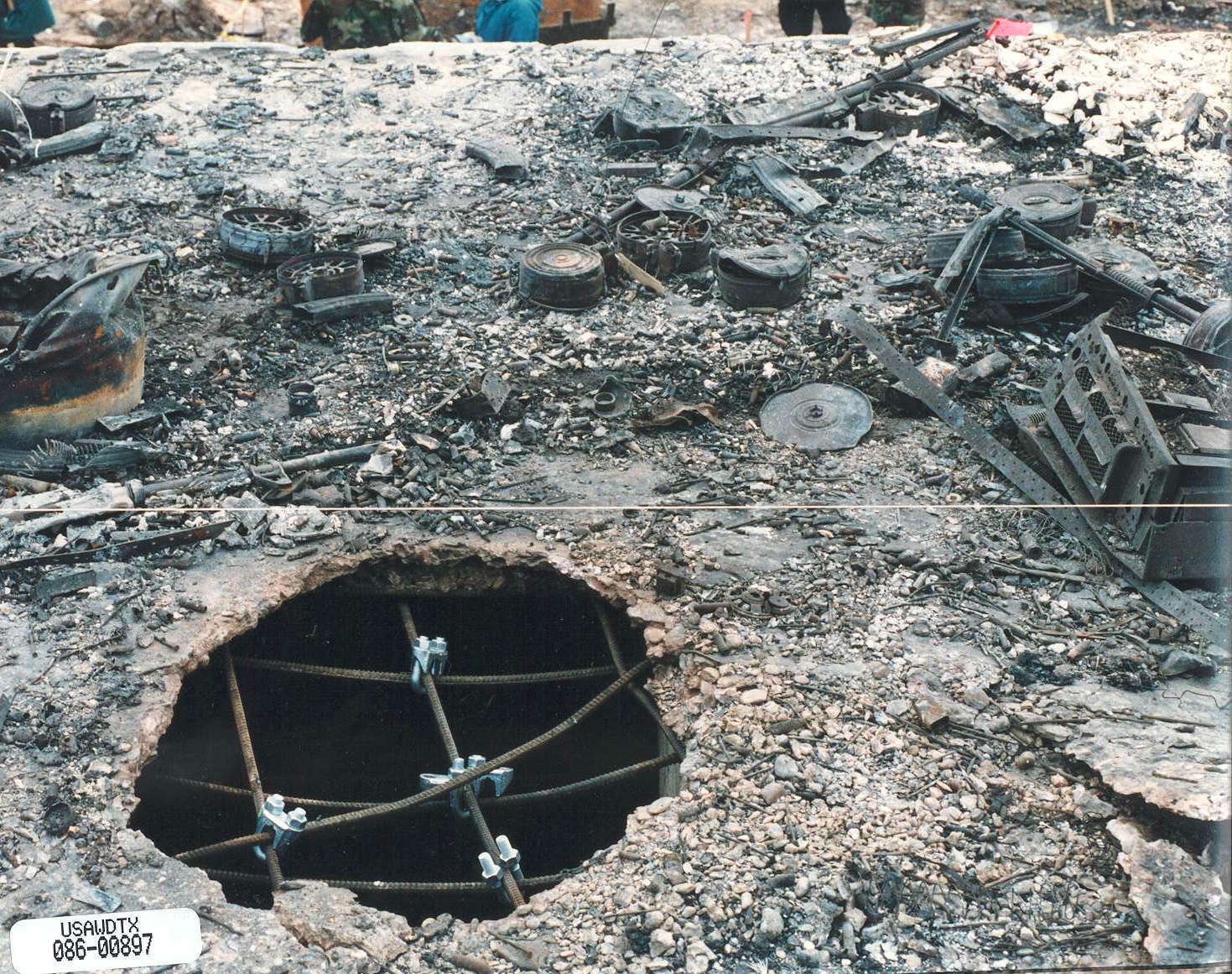
At some time during the destruction of the Center with tanks, CS gas, and fire, the roof of the concrete room was breached with a powerful explosion, likely killing anyone within by concussion and flying debris. The hole (with reinforcement steel bowed inward) and concrete debris (which would not be here while the Center was intact and operating) corroborate other evidence listed in the exhibit, What about the Explosion? No one—not the FBI, ATF, Texas Rangers, coroners, Smithsonian consultants, prosecutors of the Davidians, Davidian defense team, Davidian plaintiff's team, news "reporters," Lee Hancock, or anyone else—showed real curiosity about that hole and its causation. The probable effect of the explosion on any living person in the concrete room was likewise ignored by the coroners and those who claimed to be survivors of the fire. Click to enlarge image. |
Carol A. Valentine's |
4c. The Fireball and the Hole
Clark makes this claim: "Several FBI defendants proceeded to the second-floor and placed an explosive material on the top of the concrete Church vault at the second-floor level." (Second Amended Complaint pg. 58) Clark makes the charge but cites no evidence. Then, two paragraphs later, Clark fashions this generalized story about the deaths of the mothers and children:
"At about 12: 20 p.m., a huge explosion blasted a hole several feet in diameter on the top of the concrete ceiling and several times that wide on the bottom of the concrete ceiling of the Church vault, crushing, cutting, burying and killing or injuring most of the approximately thirty persons in the vault. A large fireball rising 160 feet above the Church vault and the remains of the Church was observed and photographed by the media and others. Photos taken of the fireball confirm its size and location. Government reports state nine bodies of Church members were found on top of the vault after the fire though the blast would make this impossible." (pg. 59)
Let's examine Clark's statement in more detail: "… a huge explosion blasted a hole several feet in diameter on the top of the concrete ceiling and several times that wide on the bottom of the concrete ceiling of the Church vault …"
According to trial testimony and photographs taken after the fire went out, the hole in the ceiling was 18 to 24 inches across. But the concrete ceiling was only six inches thick—and Clark fails to mention this fact, giving a false impression of how much concrete was displaced by the force that made the hole. The concrete from a hole this size could not "bury" anyone, let alone "approximately thirty persons" in the fashion Clark suggests, below:
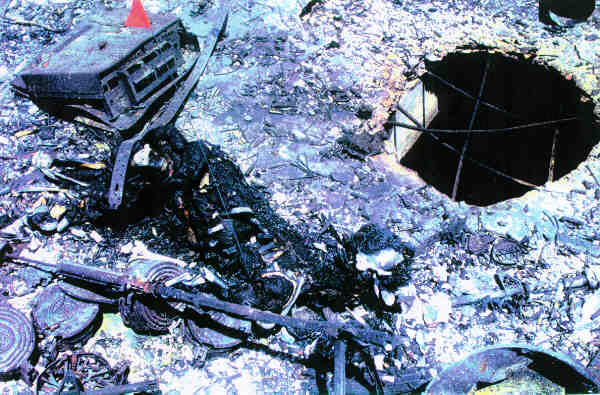
Photo donated to the Museum by an anonymous source. Click to enlarge.
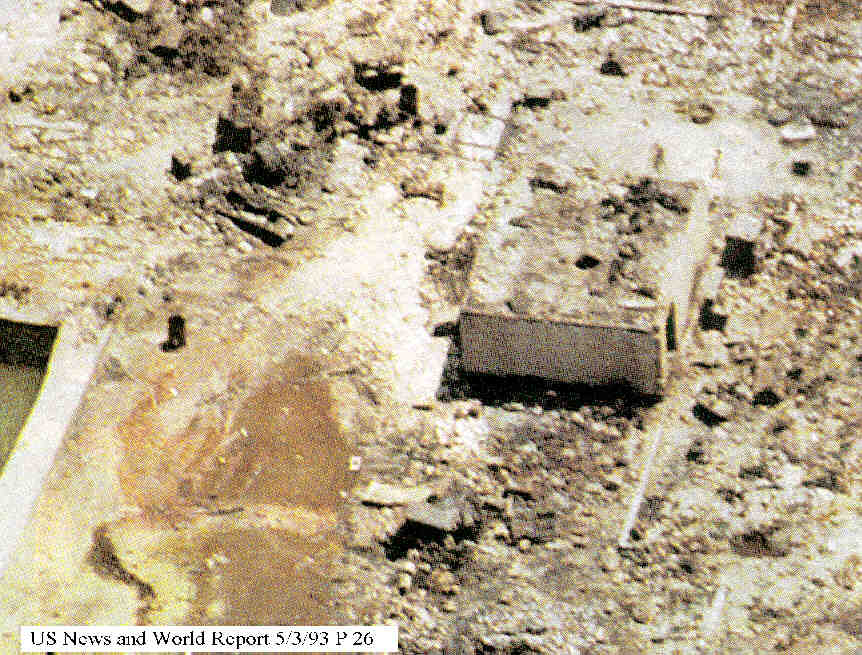
Photo published by US News & World Report, May 3, 1993, pg. 26. Click to enlarge.
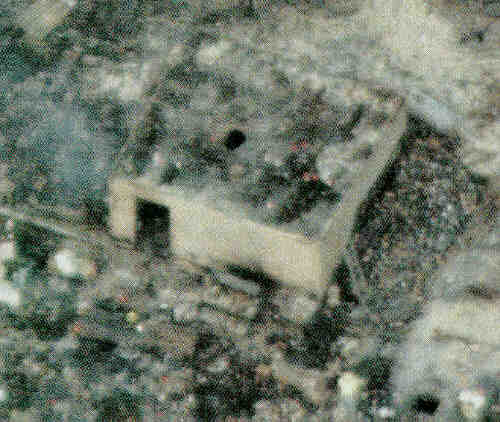
Photo published by Newsweek, May 3, 1993. Click to enlarge.
… crushing, cutting, burying and killing or injuring most of the approximately thirty persons in the vault …"
In fact, there was little debris from the roof in the concrete room. When the Texas
Ranger in charge of recovering evidence at that site testified under oath in the 1994 criminal
case, he told the court the concrete room was filled with three to four feet of exploded
ordinance, not concrete. See "Inside the Concrete Room," at
http://www.whem.org/death/page/d_la.html
Moreover, the Autopsy Reports either fail to support or contradict Clark's assertions.
- Aisha Gyarfus Summers' Autopsy Report
(Mt. Carmel Doe 31A) says the body was
damaged by an explosion *after* death.
See pg. 4, second paragraph from
bottom of page, at:
http://www.whem.org/death/death/reports/MCDoe-31.pdf - From the states of decomposition of the bodies, we know that many of the bodies found in
the vault or concrete room belonged to people who died on different dates. See List of
Decomposition States:
http://www.whem.org/death/map/d_list08.html - Many of the bodies inside the vault or concrete room were found without heads: the bodies
of Judy Schneider, "Martin Child," Rachel Howell Koresh, Rachel Sylvia, and Mayannah
Schneider. (Mt. Carmel Does 51, 61, 67-3, 67-6, and 70). No bomb, no matter how
"smart" can be relied upon to selectively remove heads; given that we have been told the
women and children were lying down and sheltering under sleeping bags and blankets in that
room, the explosion does not explain the missing heads. See "Problem of Missing Heads"
at:
http://www.whem.org/death/page/d_bcc.html - Explosions blow apart, they do not fuse. An explosion does not explain why the
remains of eleven people (Paiges Gent, Lorraine, Rachel, and Hollywood Sylvia, Star, Cyrus,
Bobbie Lane, and Rachel Howell Koresh, and three unidentified people) were found fused
together in an agglutinated mass inside that room (Mt. Carmel
Does 64,
65,
66,
67-1,
67-2,
67-3,
67-4,
67-5,
67-6,
67-7, and
67-8). For further
discussion, see "The Agglutinated Mass" at:
http://www.whem.org/death/page/d_bg.html
Clark speaks of a powerful blast, one which sent a "large fireball rising 160 feet." This bomb was powerful, but it was also smart. On one hand, it selectively blew heads off; on the other, it fused bodies together …
… A large fireball rising 160 feet above the Church vault and the remains of the Church was observed and photographed by the media and others. Photos taken of the fireball confirm its size and location … (pg. 59)
Wrong. Photos show the fireball was not centered over the vault or concrete room, but in
the area of the gymnasium. First, please locate the concrete room or vault. To do
this, go to the following URL and look at the upper diagram. You will see the concrete
"bunker" clearly indicated.
http://www.whem.org/war/fig/w_fig05.jpg
This "bunker" is the concrete storage vault in which the bodies of the mothers and children were found. The bottom diagram shows the "watchtower" or three-story residential tower. The concrete room was located at the bottom of the residential tower. Note the relative position of the flagpole and the concrete room/residential tower. Facing the Mt. Carmel Center, the flagpole is to the right of the residential tower.
These photos confirm the relative positions of the concrete room/residential tower and the
flagpole. http://www.whem.org/war/fig/w_fig17.jpg
http://www.whem.org/fire/fig/f_fig08.jpg
http://www.whem.org/fire/fig/f_fig09.jpg
http://www.whem.org/fire/fig/f_fig11.jpg
http://www.whem.org/fire/fig/f_fig14a.jpg
Now look at a photo of the fireball. Use the flagpole as an orientation point. You will
see that the fireball is NOT located over the concrete room/residential tower. Facing the
Mt. Carmel Center, the fireball is to the right of the concrete room, near the gymnasium.
http://www.whem.org/fire/fig/f_fig07.jpg
Clark continues: "Government reports state nine bodies of Church members were found on
top of the vault after the fire though the blast would make this impossible."
Impossible? Only if you accept Clark's mendacious statements about the fireball's location
and cause. In fact, there is evidence that bodies were found on top of the concrete
room. See USNews & World Report photo of May 3, 1993, showing men with stretchers
on top of the concrete room, apparently removing bodies:
http://www.whem.org/death/fig/d_fig05.jpg
Also see the following diagram, obtained in 1995 from Judge James Collier, Justice of the
Peace, Precinct 2, McLennan County, Texas. It is part of the official record, and shows
bodies were recovered from the roof of the concrete room.
http://www.whem.org/death/map/d_map03.html
No, Ramsey Clark, you have been caught. The fireball did not appear over the concrete room/residential tower at all. You are contradicted by the evidence.
4d. Mrs. O'Leary's Cow Started the Fire
Clark blames the US for the fire, using a Mrs. O'Leary's Cow explanation: Tanks smashing into the Davidian home knocked over kerosene lamps and candles, the lamps and candles set the hay on fire (Second Amended Complaint pg. 68), the US introduced of methylene chloride and ethanol into the building (pg. 69), CS accelerants, high winds (pg. 58) and "friction from crushing structural materials" with tanks (pg. 68) resulted in a fire.
But someone should have shown Clark a diagram of the Mt. Carmel Center and pointed out
the bare ground to the left of the concrete room and around the swimming pool.
This bare ground clearly was ablaze during the fire. Bare ground doesn't catch
fire unless it is treated with a flammable agent. The black smoke rising above the
inferno tells the secret: This inferno at the Mt. Carmel center was fueled by
petroleum. It was not a house fire set by candles and hay. It was a petroleum fire
typical of the fires set by Special Operations commandos when demolishing a target.
http://www.whem.org/fire/smoke/index.html
The Waco Holocaust was, of course, a Special Operations military venture from the
beginning: the evidence has been publicly available for years. You can see this
evidence in the War Gallery at:
http://www.whem.org
If Clark missed the obvious, we must ask another question: Who helped him do his investigation?
4e. Would You Trust a Spook to Investigate Waco?
Clark's investigator was long-time intelligence operative Gordon Novel, whose close ties to the CIA and the Defense Intelligence Agency (DIA) span decades. Novel certainly should have been able to recognize the tell-tale marks of a Special Operations demolition fire.
On the other hand, we might expect that Novel would protect his life-long friends in
the military/intelligence community—he is one of theirs. It would be
exceedingly naive to expect him to "investigate" Waco.
Novel admits his close ties to DIA. In an interview with the American Freedom
Network on October 10, 1996 (as mentioned above, we have confirmed the authenticity of
the interview with AFN), Novel spoke of his security company, Force One, which was in
operation at the time of the Waco raid. "At the time I had General Daniel
O'Graham, who's the, was then the ah, former Deputy Director at the CIA and the Director
of Defense Intelligence Agency."
According to the AFN transcript, Novel said he (Novel) knew of the Waco raid three weeks before the event. He was told about the raid by "a very close friend of mine, the former Special Agent in charge of ATF in New Orleans who had hired the four agents [who were killed entering the building.]"
This "close friend" — according to Novel, Mike Hall, the man who conducted the siege of The Covenant, the Sword, and the Arm of the Lord in 1985 — told Novel the Mt. Carmel raid would not succeed. Novel then called General O'Graham. Remember, according to Novel, O'Graham was at the time the Director of the Defense Intelligence Agency and on the Board of Directors of Novel's security company.
"Danny, what is going on?" Novel asked. "He says: 'I don't know.' He says, 'but whatever it is,' he says, 'it's national security.'"
Later in the interview, Novel says:
I am very pro-CIA and I can tell you that there are some good guys that still work for the FBI but not a lot of them.
Gordon Novel's name is mentioned several times by Jim Garrison in On the Trail of the Assassins (Warner Books, 1988). During his investigation of the Kennedy assassination, Garrison found a trail of evidence that led him to a group of anti-Castro Cubans—and Gordon Novel. When Garrison was trying Clay Shaw for conspiracy to assassinate Kennedy, Garrison attempted to extradite Novel from Ohio to Louisiana for the trial. Garrison's extradition efforts were thwarted by Ohio officials.
Garrison cites a number of verifications that Novel was a CIA operative (pgs. 45, 193, 208-210, 266, 353). All in all, with his admitted ties to the Defense Intelligence Agency, his admitted admiration for the CIA, and the history Garrison provides, putting Novel in charge of investigation during the preparation of a Waco lawsuit is asking a defense contractor to investigate the Pentagon.
4f. Koresh's Assassination. Too Bad Ramsey Missed It
Lee Hancock is a reporter for The Dallas Morning News. From March 1, 1993 onward, her by-line appeared on many FBI disinformation pieces on Waco that masqueraded as "news stories." Of particular interest is her front-page article of April 15, 1993, "No easy answers: law authorities puzzle over methods to end Branch Davidian siege." In the body of the article, Hancock casually mentions FBI plans to assassinate David Koresh: Note the fourth paragraph, which has been bolded for emphasis.
"WACO—For the armchair tactician, forcing an end to the 46-day Branch Davidian standoff might sound easy enough.
"Lob tear gas or other chemical agents in until the Branch Davidians are too incapacitated to fight and have no choice but to stagger out to waiting agents.
"Expose and limit their hiding places by crushing outer walls of the cult's sprawling Mount Carmel compound with Bradley fighting vehicles and 37-ton Abrams M-1 tanks.
"Pick off cult leader David Koresh with sniper fire as he peers from a window and then take the compound while his followers flounder."
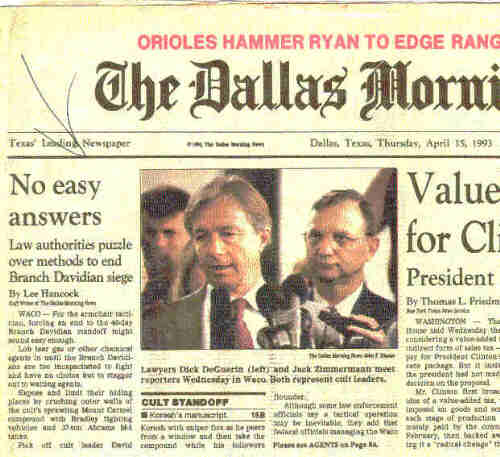
The Dallas Morning News, April 15, 1993, front page. Full text cached.
There you have it—the FBI was planning to assassinate David Koresh by shooting him in the head. What a pity Clark did not cite Hancock's report along with Koresh's Autopsy Report. See especially pages 11, 12, 13, 14, and 15: Death Reports for MC Doe 8 (David Koresh
Koresh's Autopsy Report, of course, shows he died just as the FBI planned: he died of a gunshot wound to the head. Too bad Clark did not present this evidence in his lawsuit, particularly as he represented David Koresh's mother, Bonnie Haldeman. The presentation surely would have been compelling.
4g. Do Beasts of the Field Have Names?
When the beasts of the field are slain, do their names matter? Ramsey Clark does not think so, apparently. Clark shows the same contempt for the victims as the US. He continually gets the victims' names wrong. Several women are assigned the surname "Koresh," though Koresh was never married to these women: at no time was Koresh charged with bigamy. But Clarke gratuitously assigns the name "Koresh" to women or calls them Koresh's "wife" and makes spousal claims for them.
Dana Okimoto is called "wife" of David Koresh (pg. 8); Robyn Bunds is called "wife" of David Koresh (pg. 2); Nicole Gent Little is called "Nicole Gent Koresh" (pg. 4); Michelle Jones is called "Michelle Jones Koresh" (pg. 19), and "Michelle Howell Koresh" (pg. 7). But David Thibodeau has claimed that Michelle was his wife, by which fact she would normally be called "Michelle Thibodeau." In his list of victims, Clive Doyle calls her "Michelle Jones Thibodeau."
Allegations that Koresh was a sexual profligate are carried forth in the surnames Clark assigns to many of the child victims ("Koresh"). Children born out of wedlock typically carry the names of their mothers, not their fathers. Even so, Clark can't even keep track of these names and uses them inconsistently—evidence that Clark either does not know or care about the names of the victims.
Dayland Gent is called Dayland Gent (pg. 5) and Dayland Gent Koresh (pg. 4); Paiges Gent is called Paiges Gent (pg. 5) and Paiges Koresh (pg. 4); Serenity Sea Jones is called Serenity Sea Jones Koresh (pgs. 2 and 5) and Serenity Sea Koresh (pg. 7); Chica Jones is called Chahka Jones Koresh (pg. 5), Chahka Koresh (pg. 7), and then Chica Jane Koresh (pg. 19).
Even within David Koresh's family, Clark can't keep track of the names: Rachel, David Koresh's wife, is called Rachael Jones Howell Koresh (pg. 6), Rachael Jones (pg. 7), and then Rachel Jones Koresh (pgs. 1 and 19); and even within those variations, sometimes "Rachel" is given another "a" and spelled "Rachael" (pgs. 6 and 7); Cyrus Howell is called Cyrus Ben Joseph (pg. 5) and Cyrus Howell Koresh (pg. 7); Star Howell is called Star Hadassah Howell (pg. 5) and Star Howell Koresh (pg. 7).
In the July 1, 1999 Order, Smith dismissed Bund's and Okimoto's spousal claims on the basis that they were not married to Koresh but did not comment on the invented names submitted for the other women and the invented names submitted for the children. When beasts of the field are slaughtered, do their names matter? Apparently, neither their lawyer nor this judge thinks so.
5. Judge Smith, Perjury Facilitator
As mentioned before, Judge Smith presided over the 1994 San Antonio trial of the Branch Davidians and heard the medical examiner testify about the causes of death of the Davidian mothers and children. Judge Smith knew that the Medical Examiner gave a different accounting of the deaths of the mothers and children. (See "Judge Smith And Davidian Deaths," below). None were attributed to the fireball-explosion. But in his July 1, 1999 Order, Judge Smith did not challenge Clark's off-the-wall assertions about the deaths. He did not chide Clark for omitting reference to the Autopsy Reports.
5a. None Dare Call It Collusion
Once again, we see a familiar pattern: Davidian lawyers, Department of Justice defense lawyers, and the judge—none of them want to talk about the Autopsy Reports. Part of Smith's agenda is to keep incriminating evidence against the government out of the record, and he is getting all the cooperation he needs from the plaintiffs' lawyers. This does not sound like an adversarial proceeding … but none dare call it collusion.
During the course of this 1994 trial, the judge saw many diagrams of the Mt. Carmel Center. He knew the location of the concrete room. He must have seen photos of the fireball. He must have known the fireball was in quite a different location—not over the concrete room at all. Yet in his July 1, 1999 Order, Judge Smith let Clark's false report go unchallenged.
In Footnote 8 of Smith's July 1, 1999 Order, Smith says:
Some of the more outrageous claims made by the Plaintiffs, which have absolutely no factual support, include the allegations that FBI agents (or the Delta force) entered the compound on foot, and placed an explosive device on top of the concrete bunker … Such information is supported by the rankest hearsay and other suspect sources and is totally inadmissible in a legal proceeding …
Judge Smith could be talking about his own comments, of course, but he isn't. He is attacking Clark's unsupported assertion about FBI agents placing an explosive device on the roof of the concrete room, as well he might. But by leaving Clark's statement on the location of the fireball unchallenged, Smith added validity to that lie. None dare call it collusion …
6. Michael Caddell and "The Network"
Michael Caddell's September 9, 1997 filing (Third Consolidated Complaint) asked that the US taxpayer pay over $1 billion for the government's alleged negligence in the Branch Davidian deaths. Among the plaintiffs are Livingston Fagan, Anetta Richards, Rita Riddle and her daughter Misty Ferguson, Ruth Riddle, and Sandra Connizzo, the mother of Michael Schroeder, and the ex-Mrs. Clive Doyle, Deborah K. Brown.
Caddell has received a great deal of favorable press coverage. In an article by Lee Hancock of The Dallas Morning News, Caddell complained that the US had been withholding evidence he needed to pursue his case. "Because of the government's stonewalling, we've been forced to rely on this loose-knit coalition," he is quoted as saying. "Without their getting information that the government kept from us, we wouldn't have a case." (The Dallas Morning News, October 31, 1999 "The Waco network: Loose-knit group has spurred revelations on 1993 Branch Davidian siege")
This loose-knit coalition of Caddell's included Gordon Novel (Ramsey Clark's investigator, see above) and Michael McNulty, the co-producer and director of research for the video Waco: The Rules of Engagement and researcher for the video Waco: A New Revelation.
Elsewhere in the article, Hancock discusses the motivation of the "Waco network." Some of them, says Hancock "… can't accept that authorities did not save the 17 children who died when the Davidians' compound burned on April 19, 1993." Given this concern for the dead children and the frustration at the government's stonewalling, we might expect that Caddell would use the best evidence concerning their deaths, particularly as this evidence is publicly available and voluminous.
We refer here to the Autopsy Reports which have been available from the office of the Justice of the Peace in McLennan County, Texas, since their release in 1993. Copies of the children's Autopsy Reports have been available on the World Wide Web in the Waco Holocaust Electronic Museum since the Fall of 1996, approximately one year before Caddell filed the suit.
http://www.whem.org/death/reports/county-list.html
But Caddell, like Lyons and Clark, ignores specifics. Instead of making precise statements of fact about the deaths and backing those statements with Autopsy Reports and other forensic evidence, Caddell prefers generalities and recites the usual litany:
… on April 19, 1993, in a long-planned operation, federal agents used tanks to crush the Church's buildings and insert CS gas which disabled and injured the Branch Davidians. Subsequently a fire began and rapidly consumed the Church. Most Branch Davidians were trapped because the tanks had crushed staircases and blocked exits and because the CS gas handicapped their escape. The federal agents had no firefighting equipment on the scene and delayed any equipment's subsequent arrival … Many Branch Davidians died from the fire, smoke and CS gas inhalation, and falling debris. (Third Consolidated Complaint, pg. 3).
Which Branch Davidian died of which cause? Don't ask, Caddell won't tell.
Remember, each of the dead Davidians was a distinct person. Each died his own death. Each death was caused by a specific cause or combination of causes. These causes of death were inflicted by a specific agency. In this specificity, Caddell, Clark, Ramsey, the judge, and apparently the Department of Justice defense lawyers show a remarkable lack of interest.
6a. The Ex-Mrs. Clive Doyle and the Doyle Grandchildren (?)
The inclusion of Clive Doyle's former wife, Debborah K. Brown, in the list of plaintiffs should be noted. The Chicago Tribune cited the ex-Mrs.Doyle:
Doyle survived Monday's inferno, but his 18-year-old daughter, Shari, and several grandchildren apparently did not … Doyle's former wife, Deborah Brown, who left the cult and now lives outside Waco, has told reporters her marriage to Doyle in 1970 was one of convenience arranged by cult leaders. She said she was 16 at the time and that the sole purpose of the union was to provide a legal way for Doyle, an Australian printer, to live in this county.The Doyles had two daughters, Shari and Karen, who is now 21. Karen has been living in the Branch Davidians house in LaVere, Calif. Shari became one of Koresh's "wives" and bore his children. (The Chicago Tribune, April 21, 1993, "The 9 survivors: They also lost much in the flames")
Clive Dolye's grandchildren do not appear on his list of dead, nor do they appear on the list
of those who left the Mt. Carmel Center during the siege.
http://www.whem.org/death/map/d_list03.html
http://www.whem.org/death/map/d_list01.html
This writer interviewed Clive Doyle some years ago and asked him about the whereabouts of his grandchildren. Clive denied that he had grandchildren, saying his ex-wife had been "mistaken" when she thought she had grandchildren. He explained that his ex-wife had seen photos of daughter Shari in the newspaper holding another Davidian's baby, and concluded Shari was holding her own baby.
It now seems that perhaps Deborah Brown agrees she was "mistaken" about having grandchildren. She has become a plaintiff in the civil suit, claiming damages for the death of Shari. But Brown does not claim damages for the grandchildren.
The issue of "Davidian survivors" is fraught with questions, as told in these exhibits:
Next: Waco Suits For Waco Suckers, Part 3 of 4
Previous: Waco Suits For Waco Suckers, Part 1 of 4
Burial Gallery Entrance: Introduction
Home: Museum Entrance
Search: Museum Text
| Page Data | |
| Title: | Waco Suits For Waco Suckers, Part 2 of 4 |
| URL: | http://holocausts.org/waco/burial/page/b_wsws02.html |
| Published: | 6 Dec 1999 |
| Reissued: | 4 Jul 2023 |
| Displayed: | 22 Apr 2025 |
The Waco Holocaust Electronic Museum was originally published on April 19, 1996. It has been periodically updated with improved coding and better scans of supporting documents, with additional analyses as events unfolded.
All original works copyright © 1996-2025 Carol A. Valentine. Valentine.Carol@Mail.com
Permission is freely granted for non-commercial republication with full attribution. A full statement of terms and conditions for copying and redistribution is available in the Museum Library.
"Waco Holocaust Electronic Museum," "SkyWriter," and the sky writing logo are trademarks of Public Action, Inc., 1115 Madison St. NE, #247, Salem, OR 97301-7862